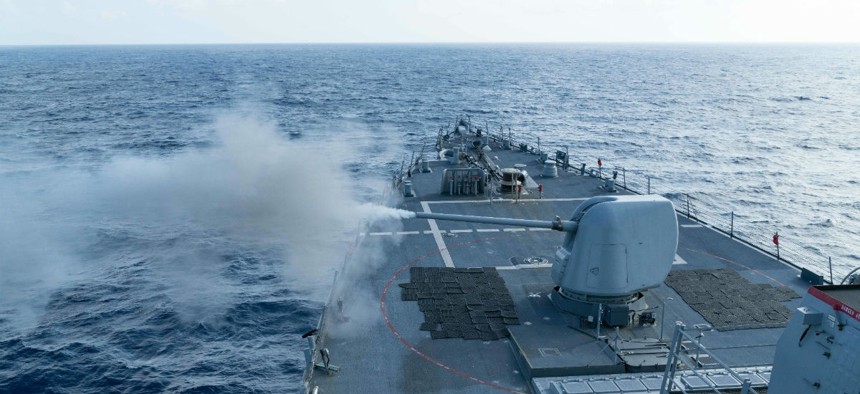
The USS Curtis Wilbur (DDG 54) conducts a live fire gunnery exercise. Lt.j.g. Jonathan Peterson/U.S. Navy
The US Is Being 'Dangerous and Irresponsible' in the South China Sea, Beijing says
A U.S. guided-missile destroyer sailed within 12 nautical miles of Triton island in South China Sea on Saturday.
A U.S. guided-missile destroyer sailed within 12 nautical miles of Triton island in South China Sea on Saturday (Jan. 30). The freedom-of-navigation operation drew rebuke, predictably, from Beijing. That’s because China considers not only the island but nearly the entire sea to be its own. It justifies its claim to the sea with a map it drew in the 1940s with a nine-dash line encircling the vast, resource-rich body of water. Each year about $5 trillion in trade passes through the sea, which also has large deposits of oil and natural gas.
Since the U.S. operation, Beijing has let loose with a full barrage of attacks from its state-controlled media.
“China drives off U.S. destroyer intruding into Xisha Islands waters,” the China Daily reported on Saturday (Jan. 30). (China calls the Paracel Islands, of which Triton is a part, the Xisha Islands.) “Chinese troops stationed at the islands and naval ships and airplanes made an immediate response, took countermeasures and conducted identification and verification against the U.S. warship,” a defense minister is quoted as saying.
A U.S. defense official told the Wall Street Journal no Chinese navy presence was seen in the area during the operation. Instead the USS Curtis Wilbur conducted its patrol, which lasted about three hours, and went on its way (paywall).
A video on China Network Television noted that “Foreign warships must have permission from the Chinese government before entering China’s territorial waters according to Chinese law on the territorial sea and contiguous zone.” Beijing issued a statement urging the United States to “respect and abide by its laws.”
China’s foreign-ministry spokesman Lu Kang called the action “dangerous and irresponsible” and said the United States was “seriously harming relevant regional peace and stability” in a briefing today (Feb. 1).
A commentary published today by the state-controlled Xinhua news wire said, “Obviously, the U.S. warship’s incursion into China’s territorial sea without authorization violated both Chinese and international law.” It goes on, “Facts have proved that China, instead of doing any harm to the freedom of navigation in the South China Sea, has provided public services to ensure the safety of all vessels sailing in the waters.”
China used the “providing a service” argument to defend its rapid construction of manmade islands in the Spratly archipelago, also part of the sea, complete with military-capable runways and other infrastructure. “Countries alongside the South China Sea and vessels sailing through the waters will receive better service,” said vice foreign minister Liu Zhenmin in October 2015.
A primary means of that “better service” is lighthouses China has built on reefs in the Spratlys. But taking advantage of the lighthouses would come at a price, Ian Storey, a South China Sea expert at Singapore’s Institute of South East Asian Studies, told Reuters. “If naval and other ships from other countries, including the United States, would be obliged to use and log them,” he said, “it could be taken as de facto recognition of China’s sovereignty.”
In October 2015 the United States sent a warship within 12 nautical miles of an island in the Spratlys, as well, exercising its freedom of navigation. It—quite deliberately—did not seek permission from Beijing to do so then, either.
NEXT STORY: America’s Misplaced Faith in Bombing Campaigns






